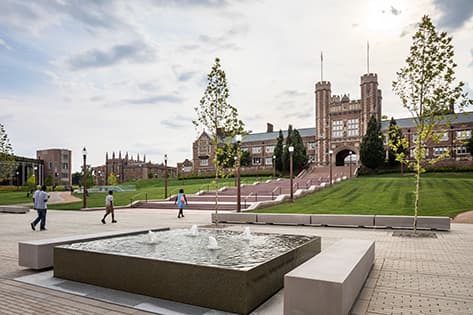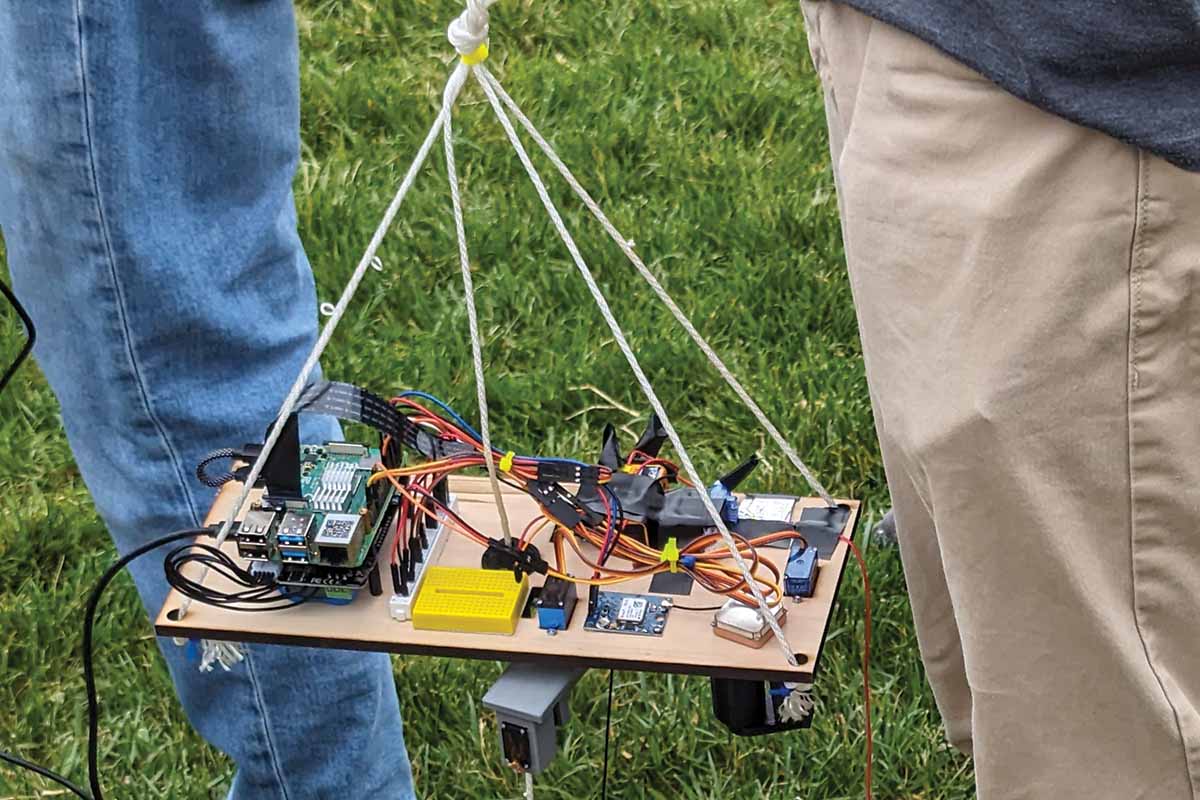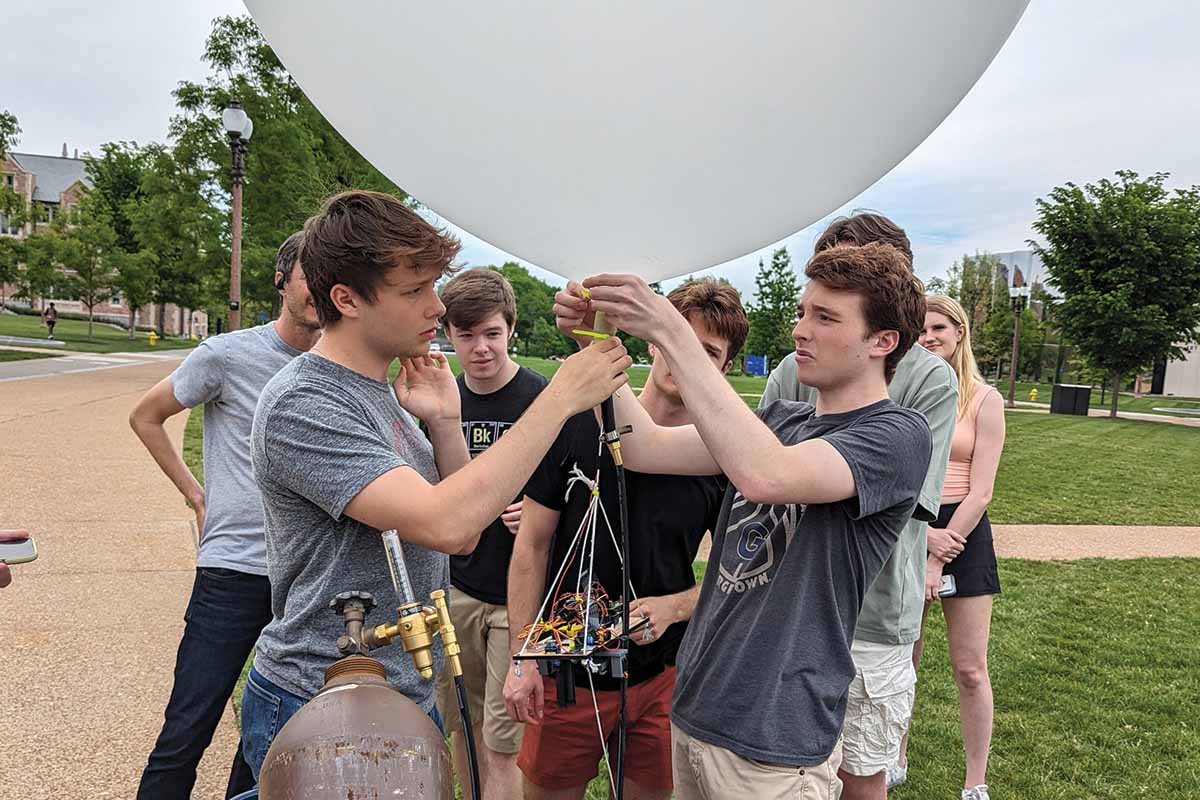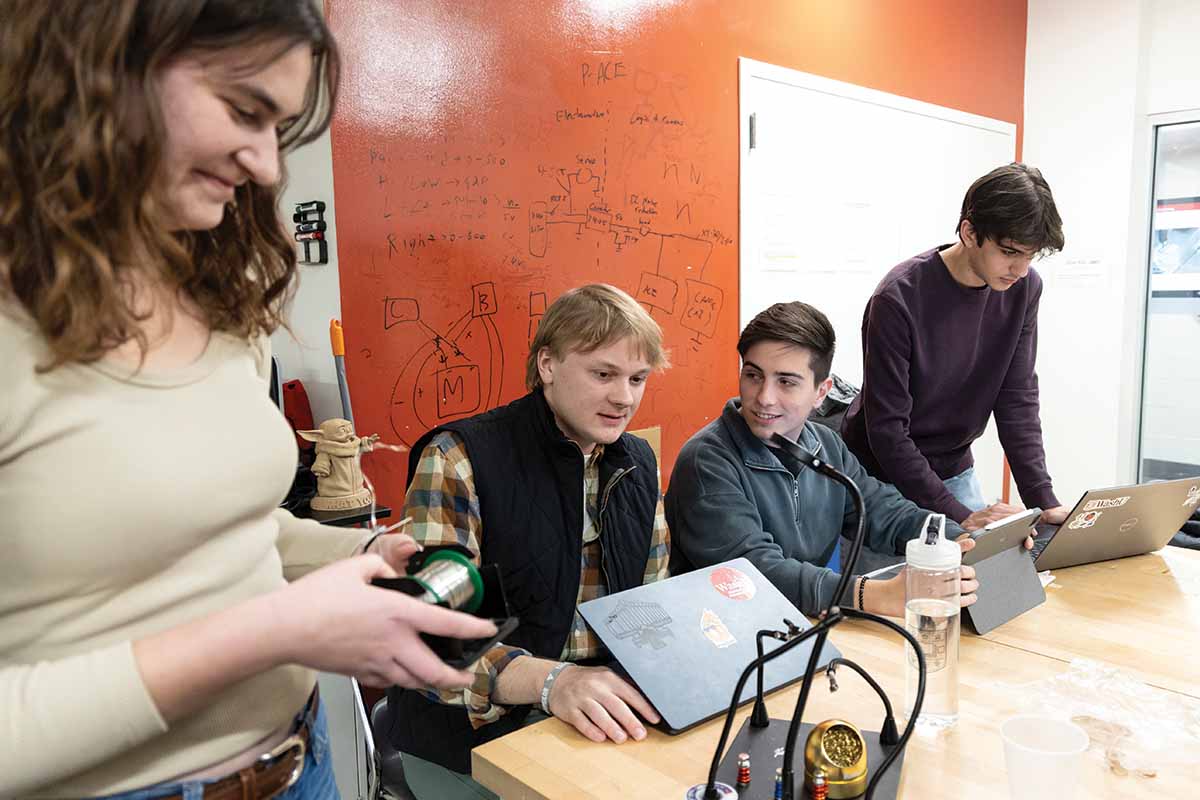On a mission
WashU Satellite has big plans for its spaceflight technologies
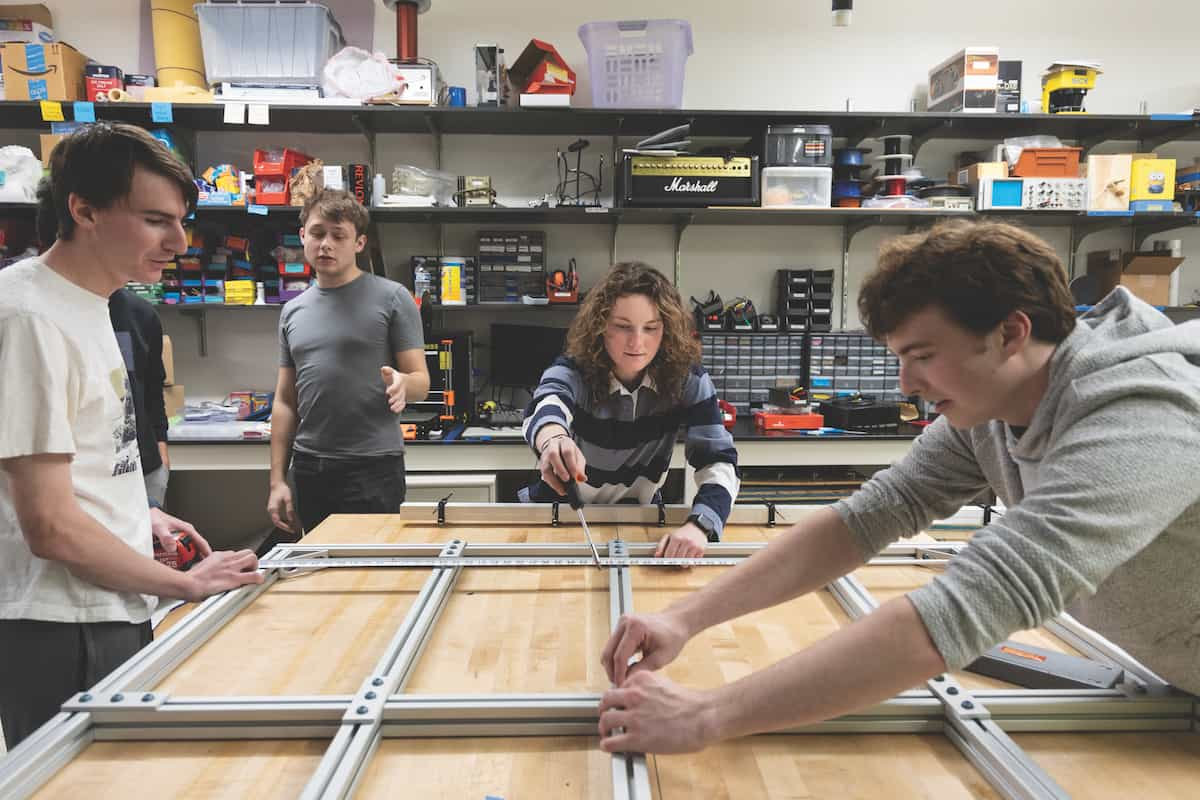
It started with a conversation between Ben Cook, a junior majoring in electrical engineering at the McKelvey School of Engineering at Washington University in St. Louis, and Aaron Bobick, dean and James M. McKelvey Professor. Cook had been thinking of starting a satellite team since high school, and Bobick encouraged him to “come back with a plan.” It was the push he needed.

The ground station's rotator will enable its antenna to move once mounted. Right: A team member tunes one of the antenna components.
Now in its second year, the WashU Satellite team is taking off. Its mission: Train future engineers, inspire interdisciplinary collaboration and provide consistent space access to advance WashU research.
“Traditionally, missions take many years and millions of dollars,” said Cook, the team’s president. “We’re trying to say, ‘Hey, let us Engineering students do it, we’ll save you a lot of money.’ It’s a great experience for WashU Engineering students and a new opportunity for WashU research.”
The team designs, builds and tests CubeSats, which are miniature, lightweight satellites used for space exploration, scientific research and testing spaceflight technologies. Made from standard, stackable 10 cm cubic units that vary in quantity, CubeSats are a cost-effective way to get payload into space with greater speed. They can be launched into Earth’s lower orbit using rockets or deployed from the International Space Station.
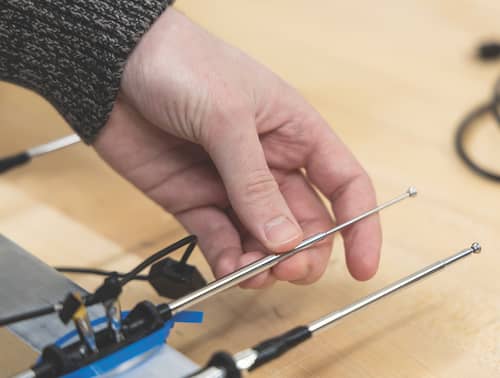
A team member tunes one of the antenna components.
In April 2024, WashU Satellite launched a small weather balloon with help from James Buckley, a professor of physics in Arts & Sciences at WashU who specializes in astrophysical research in high-energy phenomena.
“This is an incredibly hardworking, motivated team,” Buckley said. “I was impressed with the speed with which they completed their first project, which led to the weather balloon flight by the end of the last academic year.”
Balloon launch
Project manager Geoffrey Goffman, a sophomore majoring in mechanical engineering, said that although the balloon mission only flew 400 feet, it “provided an immediate project for the team to work on and allowed us to test out ideas for organizational structure, management and task delegation.”
In 2025, the team expects to continue gaining valuable experience with multiple in-progress projects. Its first ground station, a 12-foot antenna in the build-and-test phase, will help the team contact satellites in orbit and collect and analyze data. It will provide critical infrastructure that should be easily adaptable for future deployments, thanks to the use of software-defined radios which can be reprogrammed without the need for hardware modifications.
The team’s approach to its work is different from other student design teams.

Chief systems engineer
“We start by considering our constraints and use them to brainstorm a list of requirements our system must fulfill,” said chief systems engineer Owen Nieuwenhuizen, a junior majoring in computer engineering. “Then we use Model-Based Systems Engineering to visually describe the integration of all our parts before we design, review, manufacture and test to ensure that all system requirements are met.”
The team’s contribution is AIRIS, a rapidly moving optical telescope mounted on the same platform as ADAPT that will image GRB afterglows in the optical spectrum.
Leveraging innovative WashU research remains a top priority. The team is collaborating with Buckley on ADAPT, a first-of-its-kind high altitude balloon mission over Antarctica designed to detect gamma ray bursts (GRBs).
“WashU is at the forefront of this NASA-funded effort led by Professor Buckley,” said Sophie Fendler, a junior majoring in physics in Arts & Sciences at WashU and the team’s chief physicist. “Our team has secured a 20-kilogram ride-share slot, allowing us to further advance research in characterizing GRBs and their origins.”
“We’ll send back images that will be fed into NASA’s general coordinates network so other telescopes can also view these afterglows,” Fendler said. “Multi-messenger astronomy is an emerging field in astrophysics.”
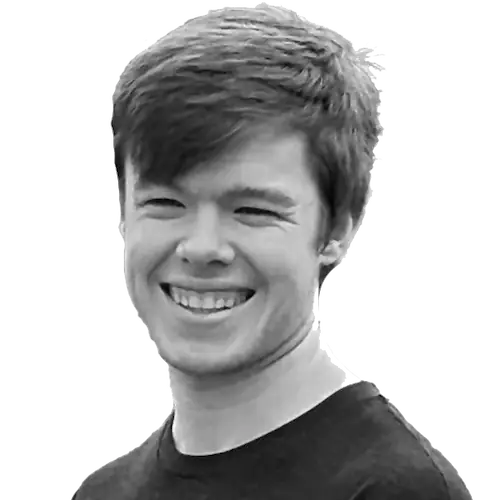
The VECTOR mission will demonstrate key research, imaging and control algorithms – very important things to all of engineering but also really important for this rapid follow-on problem for optical astronomy.”
— Ben Cook
WashU Satellite’s plans to build a portfolio for sustainable space access at WashU also include SCALAR, a single-unit CubeSat developed to demonstrate satellite design and build techniques, as well as mission operations. It will serve as a platform to test reconfigurable algorithms, a technique new to spaceflight intended to reduce the risk of new pieces of software damaging the overall mission.
In addition, the team has just developed VECTOR, a three-unit CubeSat that will build off the mission of AIRIS. Group members completed a 60-page proposal to submit VECTOR to the NASA CubeSat Launch Initiative, Goffman said.
“The VECTOR mission will demonstrate key research, imaging and control algorithms – very important things to all of engineering but also really important for this rapid follow-on problem for optical astronomy,” Cook said.
In March, WashU Satellite was selected to collaborate with NASA, the Air Force Research Laboratory, the U.S. Space Force and the Space Dynamics Laboratory to advance small-spacecraft technology through the University Nanosatellite Program (UNP) Mission Concept 2025, which includes a $50,000 grant. As part of this program, several team members will have the opportunity to spend the summer working on the VECTOR mission.
The team continues to welcome interest from the WashU community. Its membership has already grown from 15 to nearly 50, including students from four of the five Engineering departments, as well as those from Arts & Sciences, Sam Fox School of Design & Visual Arts and Olin Business School. Goffman said the team has also “been approached by a significant number of physics and computer science professors about future missions."
The appeal is clear, Cook says.
“We’re a student-led, project-based team with research implications. We’re attracting the best people and doing something that hasn’t been done previously at WashU.”
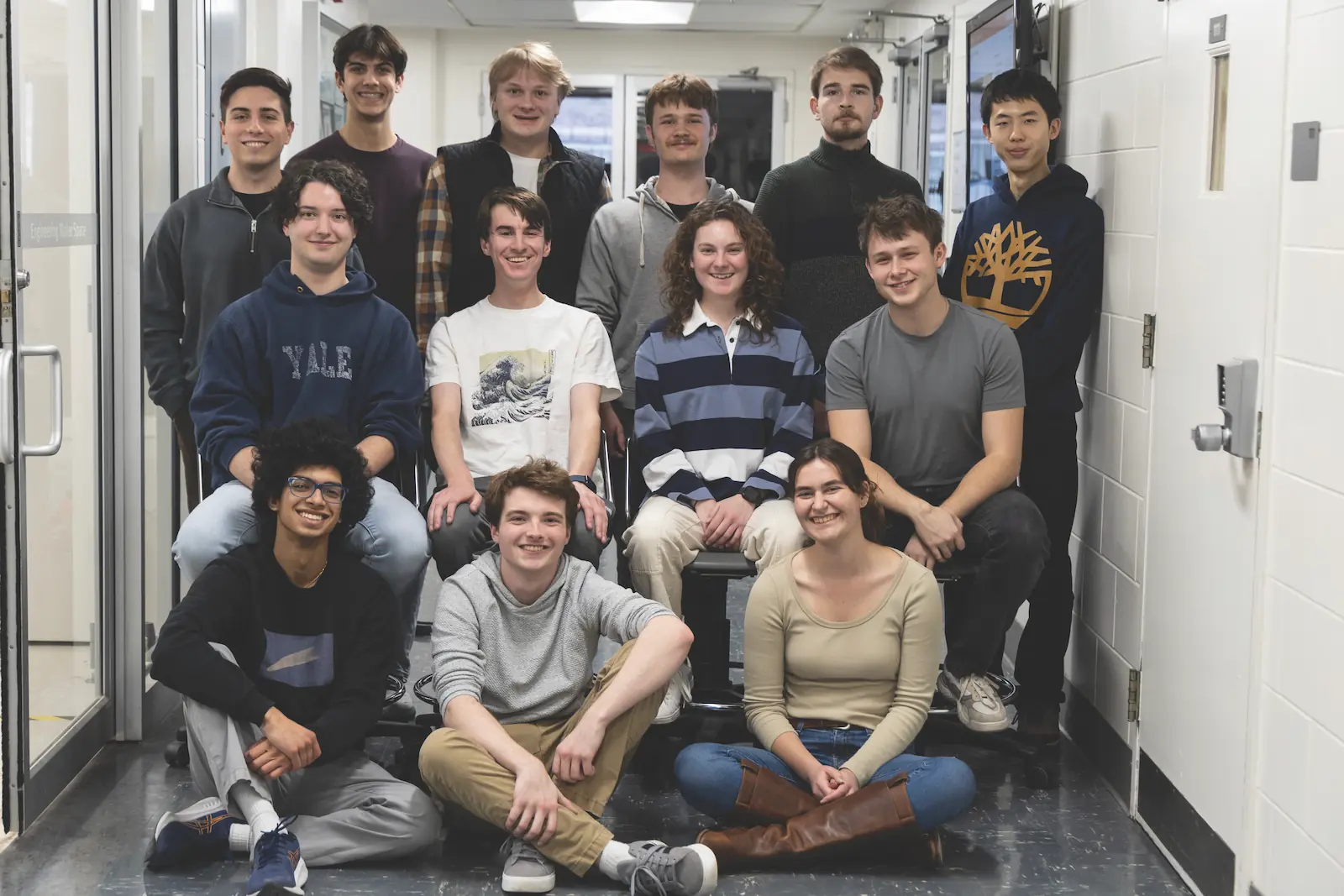
(From left) Back row: Eduardo Teixeira, Peter Essa, Sam Kendall, Owen Cromly, Nathaniel Bowman, Victor Huang. Middle row: Joe Billips, Avery Cohen, Sophie Fendler, Geoffery Goffman.
Bottom row: Aavik Wadivkar, Jack Galloway, Siri Rodin.
